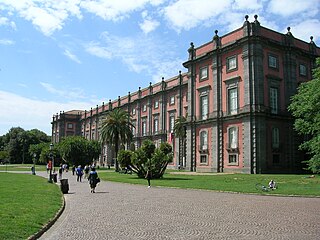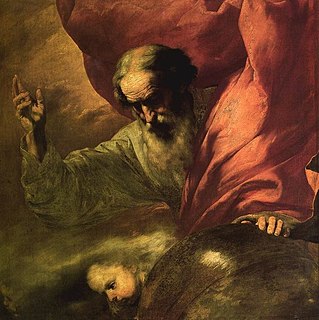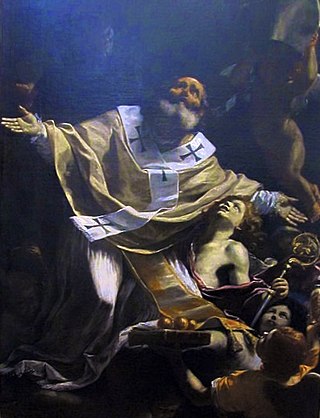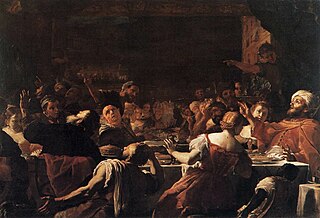
The National Archaeological Museum of Naples is an important Italian archaeological museum, particularly for ancient Roman remains. Its collection includes works from Greek, Roman and Renaissance times, and especially Roman artifacts from the nearby Pompeii, Stabiae and Herculaneum sites. From 1816 to 1861, it was known as Real Museo Borbonico.

Museo di Capodimonte is an art museum located in the Palace of Capodimonte, a grand Bourbon palazzo in Naples, Italy. The museum is the prime repository of Neapolitan painting and decorative art, with several important works from other Italian schools of painting, and some important ancient Roman sculptures. It is one of the largest museums in Italy. The museum was inaugurated in 1957.

The Naples Metro is the rapid transit system serving the city of Naples, Italy. The system comprises three underground rapid transit lines.

The Biblioteca nazionale Vittorio Emanuele III is a national library of Italy. It occupies the eastern wing of the 18th-century Palazzo Reale in Naples, at 1 Piazza del Plebiscito, and has entrances from piazza Trieste e Trento. It is funded and organised by the Direzione Generale per i Beni Librari and the Ministero per i Beni e le Attività Culturali.

The Royal Palace of Capodimonte is a large palazzo in Naples, Italy. It was formerly the summer residence and hunting lodge of the Bourbon kings of the Two Sicilies, one of the two royal palaces in Naples. Today, it comprises the National Museum of Capodimonte and the Royal Forest. The palace was constructed on its somewhat cooler hilltop location just outside the city, with urban Naples ultimately expanding around it.

The following is a timeline of the history of the city of Naples. The Naples area has been inhabited since the Neolithic period. The earliest historical sources in the area were left by the Myceneans in the 2nd millennium BC. During its long history, Naples has been captured, destroyed and attacked many times. The city has seen earthquakes, volcanic eruptions, foreign invasions and revolutions.

The Temples of Paestum is an 1824 painting by Antonie Sminck Pitloo. It shows two of the temples at Paestum, probably during an excavation.

Ptolemy Philadelphus in the Library of Alexandria is an 1813 oil on canvas painting by Vincenzo Camuccini. It is now in the National Museum of Capodimonte in Naples.

Sacrificial Scene is a grisaille tempera on canvas painting by Pontormo, produced around 1520 and now in the National Museum of Capodimonte in Naples. It was probably originally produced as part of the decoration of an interior in honour of Cosimo de' Medici.

Portrait of Maria Luisa of Parma is a portrait of Maria Luisa of Parma, wife of Charles IV of Spain, produced as a pendant painting to a portrait of her husband. Both works were long thought to be a copy after an autograph work by Francisco Goya, but they have now been definitively reattributed as autograph works by Goya himself, produced late in the 18th century. Goya was a court artist to the royal family, though most of his paintings of them are still in the Prado Museum. The two works were commissioned by the couple's daughter Maria Isabella of Spain. They were sent to Maria Isabella and they are both now in the National Museum of Capodimonte in Naples.

Madonna and Child with Donors or Sacred Conversation with Donors is a c. 1525 oil on panel painting by Palma Vecchio, now in the Museo nazionale di Capodimonte in Naples.

Portrait of Cardinal Alessandro Farnese is a c. 1545-1546 oil on canvas three-quarter-length portrait of Alessandro Farnese the Younger (1520-1589) by Titian, now in the Museo nazionale di Capodimonte in Naples.

Madonna of Constantinople is a c. 1656 oil on canvas painting by Mattia Preti. It was the first of many works commissioned as ex-votos for freeing the city from the plague of 1656 – they all showed the Madonna with a selection of the city's patron saints, in this case Joseph, Januarius, Roch, Nicasius and Rosalia (centre). It now hangs in the Museo nazionale di Capodimonte in Naples.

Portrait of Pope Paul III with Camauro is a 1545 – 1546 oil on canvas painting by Titian, now in the Museo nazionale di Capodimonte in Naples.

The Earthly Trinity with Saints and God the Father are a pair of c.1626-c.1635 oil on canvas paintings by Jusepe de Ribera, both now in the Museo nazionale di Capodimonte in Naples. Along with the Holy Family, the main work shows Bruno of Cologne, Benedict of Nursia, Bernardino of Siena and Bonaventure.

Saint John the Baptist is a c.1653-1656 oil on canvas painting by Mattia Preti, now in the Museo nazionale di Capodimonte in Naples.

Saint Nicholas is a c. 1653 painting by Mattia Preti, the first work he produced after moving to Naples and showing the three gold balls which are a traditional attribute of the saint. It is now in the Museo nazionale di Capodimonte in the same city. He also produced a larger version of the work in 1657 which is now in the Pinacoteca civica in Fano, with an early copy after the Capodimonte version now in the church of Santa Teresa degli Scalzi in Naples.

The Banquet of Absalom is an oil on canvas painting by Mattia Preti, created in c. 1660–1665, now in the Museo nazionale di Capodimonte in Naples. It illustrates a passage from chapters 13 and 14 of 2 Samuel in the Old Testament, in which King David's son Absalom avenges the rape of Absalom's sister Tamar two years earlier by inviting her rapist Amnon to a feast, getting him drunk and then killing him.

Belshazzar's Feast is a circa 1660-1665 oil on canvas painting by Mattia Preti, now in the Museo nazionale di Capodimonte in Naples. It shows a scene from chapter 5 of the Book of Daniel.























